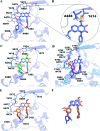Discovery and biological evaluation of N5-substituted 6,7-dioxo-6,7-dihydropteridine derivatives as potent Bruton's tyrosine kinase inhibitors
- PMID: 30108960
- PMCID: PMC6071741
- DOI: 10.1039/c8md00019k
Discovery and biological evaluation of N5-substituted 6,7-dioxo-6,7-dihydropteridine derivatives as potent Bruton's tyrosine kinase inhibitors
Abstract
Bruton's tyrosine kinase (BTK) plays a critical role in B cell receptor (BCR)-mediated signaling pathways responsible for the development and function of B cells, which makes it an attractive target for the treatment of many types of B-cell malignancies. Herein, a series of N5-substituted 6,7-dioxo-6,7-dihydropteridine-based, irreversible BTK inhibitors were reported with IC50 values ranging from 1.9 to 236.6 nM in the enzymatic inhibition assay. Compounds 6 and 7 significantly inhibited the proliferation of Ramos cells which overexpress the BTK enzyme, as well as the autophosphorylation of BTK at Tyr223 and the activation of its downstream signaling molecule PLCγ2. Overall, this series of compounds could provide a promising starting point for further development of potent BTK inhibitors for B-cell malignancy treatment.
Figures




Similar articles
-
Design, synthesis and biological evaluation of novel 2-phenyl pyrimidine derivatives as potent Bruton's tyrosine kinase (BTK) inhibitors.Medchemcomm. 2019 Jan 16;10(2):294-299. doi: 10.1039/c8md00413g. eCollection 2019 Feb 1. Medchemcomm. 2019. PMID: 30881616 Free PMC article.
-
Discovery and Biological evaluation of pyrimido[4,5-d]pyrimidine-2,4(1H,3H)-dione derivatives as potent Bruton's tyrosine kinase inhibitors.Bioorg Med Chem. 2019 Aug 1;27(15):3390-3395. doi: 10.1016/j.bmc.2019.06.023. Epub 2019 Jun 12. Bioorg Med Chem. 2019. PMID: 31221612
-
Development of a pharmacodynamic assay based on PLCγ2 phosphorylation for quantifying spleen tyrosine kinase (SYK)-Bruton's tyrosine kinase (BTK) signaling.J Biomol Screen. 2013 Sep;18(8):890-8. doi: 10.1177/1087057113489881. Epub 2013 May 23. J Biomol Screen. 2013. PMID: 23704133
-
Role of Bruton's tyrosine kinase in B cells and malignancies.Mol Cancer. 2018 Feb 19;17(1):57. doi: 10.1186/s12943-018-0779-z. Mol Cancer. 2018. PMID: 29455639 Free PMC article. Review.
-
The development of Bruton's tyrosine kinase (BTK) inhibitors from 2012 to 2017: A mini-review.Eur J Med Chem. 2018 May 10;151:315-326. doi: 10.1016/j.ejmech.2018.03.062. Epub 2018 Mar 23. Eur J Med Chem. 2018. PMID: 29631132 Review.
Cited by
-
Derivatisation of parthenolide to address chemoresistant chronic lymphocytic leukaemia.Medchemcomm. 2019 Aug 1;10(8):1379-1390. doi: 10.1039/c9md00297a. eCollection 2019 Aug 1. Medchemcomm. 2019. PMID: 32952998 Free PMC article.
-
Design, synthesis and biological evaluation of novel 2-phenyl pyrimidine derivatives as potent Bruton's tyrosine kinase (BTK) inhibitors.Medchemcomm. 2019 Jan 16;10(2):294-299. doi: 10.1039/c8md00413g. eCollection 2019 Feb 1. Medchemcomm. 2019. PMID: 30881616 Free PMC article.
References
-
- Smith C., Islam T. C., Mattsson P. T., Mohamed A. J., Nore B. F., Vihinen M. BioEssays. 2001;23:436–446. - PubMed
-
- Buggy J. J., Elias L. Int. Rev. Immunol. 2012;31:119–132. - PubMed
-
- Bradshaw J. M. Cell. Signalling. 2010;22:1175–1184. - PubMed
-
- Mohamed A. J., Yu L., Bäckesjö C. M., Vargas L., Faryal R., Aints A., Christensson B., Berglöf A., Vihinen M., Nore B. F., Smith C. I. E. Immunol. Rev. 2009;228:58–73. - PubMed
LinkOut - more resources
Full Text Sources
Other Literature Sources
Molecular Biology Databases

